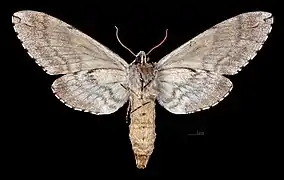Ceratomia undulosa
Ceratomia undulosa, the waved sphinx, is a moth of the family Sphingidae. The species was first described by Francis Walker in 1856.[1]
| Waved sphinx | |
|---|---|
.jpg.webp) | |
| Adult specimen | |
| Scientific classification | |
| Kingdom: | Animalia |
| Phylum: | Arthropoda |
| Class: | Insecta |
| Order: | Lepidoptera |
| Family: | Sphingidae |
| Genus: | Ceratomia |
| Species: | C. undulosa |
| Binomial name | |
| Ceratomia undulosa (Walker, 1856) | |
| Synonyms | |
| |
Distribution
It is found in the United States, and southern Canada, east of the Rocky Mountains. Adult moths are strictly nocturnal, hiding away as dawn approaches (Fullard & Napoleone 2001).
Description
 Male
Male Male underside
Male underside Female
Female Female underside
Female underside.jpg.webp) Caterpillar
Caterpillar
Biology
Recorded food plants of the larvae include Fraxinus and possibly Quercus species.
Larvae then dig underground to pupate.
Subspecies
- Ceratomia undulosa undulosa (from Prince Edward Island and Nova Scotia west to eastern Alberta and Maine to Florida west to the eastern Great Plains and south to Florida, the Gulf Coast and Texas)
- Ceratomia undulosa polingi Clark, 1929 (Mexico)
References
- "CATE Creating a Taxonomic eScience - Sphingidae". Cate-sphingidae.org. Archived from the original on July 21, 2012. Retrieved November 1, 2011.
- Fullard, James H.; Napoleone, Nadia (2001). "Diel flight periodicity and the evolution of auditory defences in the Macrolepidoptera" (PDF). Animal Behaviour. 62 (2): 349–368. doi:10.1006/anbe.2001.1753. Archived from the original (PDF) on 2007-06-15.
External links
- "Waved sphinx (Ceratomia undulosa)". Moths of North America. U.S. Geological Survey Northern Prairie Wildlife Research Center. Archived December 7, 2005.
- Fauske, Gerald M. (January 23, 2007). "Ceratomia undulosa (Walker 1856)". Moths of North Dakota. Department of Entomology North Dakota State University. Retrieved December 13, 2020.
This article is issued from Wikipedia. The text is licensed under Creative Commons - Attribution - Sharealike. Additional terms may apply for the media files.